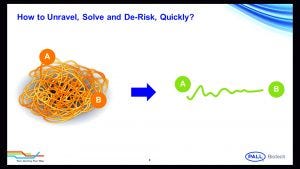- Sponsored Content
An End-to-End Integrated-Solutions Approach to Commercial Viral Vector ManufacturingAn End-to-End Integrated-Solutions Approach to Commercial Viral Vector Manufacturing
August 27, 2020
Sponsored by Cytiva
 Jeremy Rautenbach, global product manager, Biotech Integrated Solutions, Pall Biotech
Jeremy Rautenbach, global product manager, Biotech Integrated Solutions, Pall Biotech
Rautenbach emphasized the importance of timely decision-making in the context of viral vector manufacturing. He stressed the importance of quantifying requirements for biomanufacturing skills early in a process and showed how platform approaches can accelerate market entry and reduce risks to ensure manufacturing readiness at the point of approval. Key operational decisions can be well-informed, planned for, and executed by the time a drug is intended to be approved.
Committing large sums of capital early in a development process (investing heavily in future commercial manufacturing capabilities) is certainly not without risk. But such commercial readiness at the point of approval can influence a company’s ability to capture market share as soon as possible. The challenge is to have a high degree of confidence in your manufacturing readiness early on. Another consideration is to find a way to compress facility- and equipment-build stages so as to delay commitment of capital until such time as the risk-adjusted net present value (NPV) is as favorable as possible. Rautenbach spoke about how to become manufacturing ready by the time of commercialization, how to unravel difficult questions and to do so at speed, and how to pay due consideration to long-term manufacturing and supply-chain risks.
Typically, three main strategies can be applied. One approach is to project-manage an entire process with a company’s internal resources, examining whether those resources will be adequate; incorporate current process thinking; and factor in ongoing supply aspects. A second strategy is to outsource an entire process to a third-party project-management house with the necessary bandwidth and process knowledge to construct manufacturing solutions. A manufacturer still might need to manage residual manufacturing and supply risks (especially if working with multiple vendors) when problems need to be resolved quickly. And a third option is for a single vendor to provide an entire manufacturing solution. The right partner will demonstrate a deep understanding of its own equipment and the knowledge to integrate that equipment into manufacturing solutions.
Pall Biotech supports projects from early phase clinical development through to commercial-scale manufacturing. With single-use consumables that span media and buffer processes all the way to sterile filtration, Pall can move key conversations quickly into project execution, reducing manufacturing risks.
The company’s services rest on three key pillars. The first pillar, formed of Pall’s accelerated process-development services (PDS) team, specializes in designing, optimizing, and transferring new processes from preclinical to scalable good manufacturing practices (GMP)–ready manufacturing processes. The second pillar encompasses established standard bioprocessing platforms for monoclonal antibodies (MAbs), adenoassociated viruses (AAVs), and lentiviruses in both adherent and suspension cell cultures and applying adeno- and oncolytic-bioprocessing solutions. The third pillar rests on project-management capabilities toward developing integrated manufacturing solutions. A three-dimensional modeling tool and process-flow diagrams start to build a realistic picture of interconnecting pieces of equipment required to make a process work.
Rautenbach shared a case study in which a customer with a 3-L adenovirus process wanted help developing a full 200-L suspension-based solution. The PDS team scaled that process from three to 200 liters within six weeks, and subject matter experts delivered a complete manufacturing proposal within eight weeks, thanks to the ability to leverage Pall’s internal resources and proven bioprocessing platforms.
Rautenbach concluded by emphasizing the need to define manufacturing requirements early in process development. Leveraging platform solutions enables faster market entry with the assurance of manufacturing process robustness. Working with a single vendor can offer significant strategic benefits toward developing an integrated solution for efficient scale-up to commercial manufacturing.
Watch the complete presentation now.
You May Also Like






